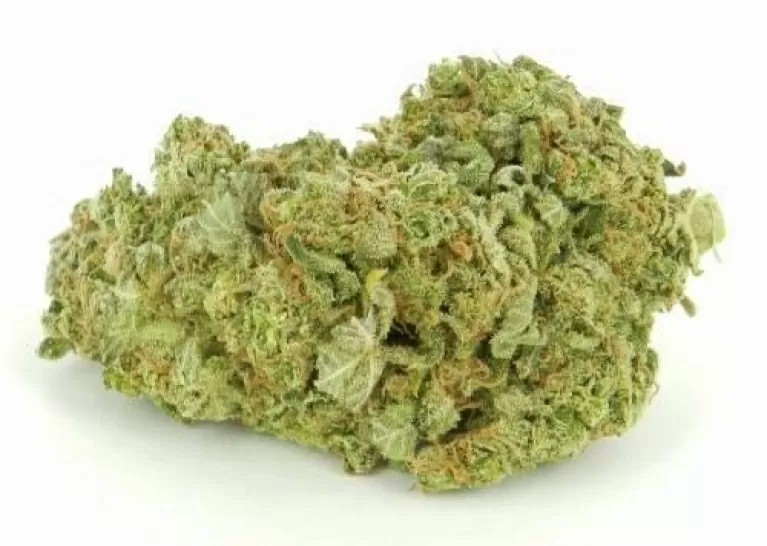Considered to be one of the best-known and most popular cannabis strains of all time, Skunk was created around the 1980s by hybridising pre-existing strains from Afghanistan, Mexico and Colombia.
Being a cross between indica and sativa cannabis, Skunk can be indica-dominant, with mostly body-building effects, or sativa-dominant, with mostly cerebral effects. Skunk has been an instant hit with regular marijuana users and won the first Cannabis Cup.
The origin of its name is rather curious: skunk is in fact an English word meaning 'skunk', an adjective due to its characteristic pungent and persistent odour, unique and absolutely recognisable compared to the many varieties of marijuana currently available.
Widespread throughout the world, it has a THC concentration that can easily reach 15% - 25%, even though it was Professor Leslie Iversen, a pharmacologist at Oxford University, who disproved the widely held belief that skunk was a variety of cannabis with a tetracannabidiol concentration 20 or 30 times higher than previously recognised strains, a view further confirmed by studies published in The Guardian in 2007.
However, regardless of the concentration of active ingredients present, Skunk is one of the most sought-after strains among marijuana connoisseurs, thanks to its unmistakable aroma and undeniably noteworthy psychotropic effects.
What is Skunk and how can we recognise quality Skunk
Skunk is one of the first freely marketed cannabis strains. The result of careful study and research into the specific selection of seeds from over 20,000 available strains from all over the world, Skunk was created from a hybridisation of an Afghani, an Acapulco Gold and a Colombian Gold, resulting in an exceptional strain.
Today, she is recognised worldwide and has had a significant influence on the marijuana industry. In the UK, the term 'skunk' is used to describe beautiful indoor buds that are not necessarily derived from the original.
Suitable for beginners as well as those who don't have a lot of space in which to grow their crops, the Skunk variety retains all the typical characteristics of the genetic lines from which it is derived: the typical Colombian genetics produce tall plants with particularly consistent, dense and generous buds, while the Mexican genetics are able to control growth, significantly reducing flowering time.
The presence of Afghan genetics gives the plants a compact appearance and characteristic stability. As a result of these acquired characteristics, Skunk is particularly hardy, not very susceptible to stress and able to adapt easily to all weather conditions. Leaves are large and appear golden yellow to green in colour.
How do you recognise quality Skunk? Mostly by the buds, which are generally dense, compact and generously resinous, with a typical pungent smell and the ability to expand easily when dried and ground with a grinder. The characteristic flavour is unmistakable and makes the variety easily recognisable: hints of orange and flowers combine to create a unique hit.
Skunk: characteristics, THC levels and main effects
Skunk is one of the most recently produced varieties of cannabis, the result of hybridising two extremely popular varieties: cannabis sativa and cannabis indica, also known as dominant cannabis sativa.
Among the main features that make Skunk so popular with regular users and beginners alike is the relative simplicity of its cultivation. The plants are tall, sturdy and hardy but easy to manage, with large, green/golden-yellow leaves and dense, compact inflorescences that are extremely rich in resin, while maintaining a relatively short flowering period.
Despite the fact that, over the years, these values have contributed to a number of disputes regarding the concentration of the active ingredient, which have been refuted by careful scientific studies, Skunk has a THC content of between 15% and 25%, making it one of the most potent strains.
Its effects are considered to be dispersive, i.e. capable of causing perceptions and sensations that vary according to the characteristics and personal situation of the subject at the time of intake. It generally leads to a state of euphoria and well-being that is always related to the psychological state of the subject, amplifying it and showing a simultaneous bodily and cerebral perception of what he is experiencing at that moment.
Side effects of Skunk
Smoking Skunk causes effects that can sometimes be comparable to those of taking LSD (or other hallucinogens), due to the massive concentration of THC or tetracannabidiol, which can range from 15-25%, compared to 3-5% in most common marijuana strains.
When skunk is taken, purely subjective actions and sensations occur, and perception of the subject's surroundings is exaggerated. When used in particularly high doses, it can lead to distortions in the perception of time, space and the body, often associated with visual and/or auditory hallucinations, as well as depersonalisation associated with a feeling of detachment from one's own body.
This is because this genetic line is considered to be 'dispersive', amplifying feelings of well-being and euphoria but also sadness and unpleasant thoughts, leading in some cases to anxiety, aggravated by paranoid and highly negative thoughts and attitudes.
The subject's psychological state therefore plays an important role, because depending on it, the effects of skunk can vary considerably, involving suggestion, fear, vomiting, excessive sweating and a marked increase in heart rate.
Main Skunk strains
There are many varieties of Skunk #1 derivatives, all sharing the same organoleptic characteristics but differing in THC concentration, aroma and hit. Here are the main ones.
Super Skunk or Skunk XL
Super Skunk has been around since 1990 and has since become a highly successful, award-winning strain and one of the most popular genetics ever created. Developed from Skunk #1 crossed with an Afghani strain, unlike the original it is indica-dominant, resulting in purely physical effects such as weightlessness and pain reduction, as well as promoting meditation.
Perfect for those who want to relax after a hard day's work, it requires special control over dosage as it has very high THC concentrations that can knock out even the most regular users. Significantly sweeter than the original variety, it inherits its large, compact buds and large branches, with a flowering period of around 40/50 days.
OG Skunk
Also very popular is the OG Skunk variety, a hybridisation of OG #18 and Skunk #1, which is considered extremely strong due to its THC concentration of around 21%.
The effects of taking it are characterised by a propensity for optimism and productivity, leading to a desire to complete unfinished tasks.
Mostly cerebral, however, it can give rise to the canonical side-effects typical of an excess of tetracannabidiol. It is also easy to grow, both indoors and outdoors, and can be used in rather hostile environments and climates.
The production yield is also excellent in terms of inflorescences which appear in a flowering period of 7 to 9 weeks and are full-bodied, dense, large and proverbially rich in resin.
Lemon Skunk
Also of note is the famous Lemon Skunk, also listed in the High Times Top 10, a true authority when it comes to cannabis. Its THC content can easily reach 22%, resulting mainly in cerebral effects.
Most users have experienced a marked increase in creativity, while others have experienced a good mood and high energy. However, it can also cause often unpleasant side-effects such as dry mouth and eyes, paranoia, dizziness and anxiety, especially if used in excessive quantities.
From a purely biological point of view, it retains the same characteristics as the original genetic line: robust, hardy, well-developed plants, a relatively short flowering period and consistent, resinous inflorescences with a characteristic citrusy aroma dominated by the fresh, heady scent of lemon.
Orange Bud
One of the best-known Skunk strains is undoubtedly the well-known Orange Bud, which has been popular since the 1980s for its strong adaptability and ease of cultivation for experts and beginners alike.
Suitable for both indoor and outdoor cultivation, it is particularly stable, always offering the best results in terms of yield from the inflorescences, which are always compact, large and rich in resin. With a high THC concentration, it provokes both cerebral and physical effects, favoured by a marked hit and by distinctly citrusy, nectarine, fresh and pleasantly persistent scents on the palate.
How to grow Skunk indoors and outdoors
Popular not only with hunters but also with growers, the Skunk variety stands out for being easy to grow even for amateurs and newbies as she can easily withstand the most insidious environmental conditions and is easy to handle without fear of infestation.
When grown indoors or indoors, Skunk offers an above-average yield, with an estimated 500g of buds per square metre and a flowering period of 8 to 9 weeks. When grown outdoors, she is usually ready for harvest between September and October, with an average estimated yield of over 600g of buds per plant.
 Italiano
Italiano Español
Español English
English Français
Français Deutsch
Deutsch
